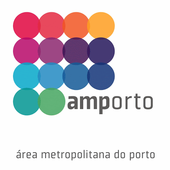Porto Metropolitan Area
Área Metropolitana do Porto | |
|---|---|
|
Clockwise: Liberdade Square; Congregados Church; high-rises on Avenida da Boavista; view of Vila Nova de Gaia; Port of Leixões in Matosinhos; aerial view of the Porto Metropolitan Area; view of central Porto. | |
 | |
| Core city | Porto |
| Municipalities | Arouca, Espinho, Gondomar, Maia, Matosinhos, Oliveira de Azeméis, Paredes, Porto, Póvoa de Varzim, Santa Maria da Feira, Santo Tirso, São João da Madeira, Trofa, Vale de Cambra, Valongo, Vila Nova de Gaia and Vila do Conde. |
| Government | |
| • President | Eduardo Vítor Rodrigues (PS) |
| Area | |
| • Total | 2,040.31 km2 (787.77 sq mi) |
| Population (2018) | |
| • Total | 1,737,395[1] |
| GDP | |
| • Total | €39.179 billion (2022) |
| • Per capita | €22,603 (2022) |
| HDI (2017) | 0.835[4] very high · 2nd |
| Website | Official website |
The Porto Metropolitan Area (Portuguese: Área Metropolitana do Porto; abbreviated as AMP) is a metropolitan area in northern Portugal centered on the City of Porto, Portugal's second largest city.[5] The metropolitan area, covering 17 municipalities, is the second largest urban area in the country and one of the largest in the European Union, with a population in 2021 of 1,737,395[1] in an area of 2,040.31 km².[6][7]
The Porto Metropolitan Area is a major economic engine in Portugal, with a very high HDI (Human Development Index) and a GDP above the European average.[4] Porto has been Portugal's largest manufacturing region since the Industrial Revolution and is home to many of the country's largest corporations.
It is chaired by Eduardo Vítor Rodrigues (PS).
- ^ a b INE (2021). "Censos 2021".
- ^ "Produto interno bruto (B.1*g) a preços correntes (Base 2016 - €) por Localização geográfica (NUTS - 2013); Anual". www.ine.pt. Retrieved 3 September 2023.
- ^ "Produto interno bruto (B.1*g) por habitante a preços correntes (Base 2016 - €) por Localização geográfica (NUTS - 2013); Anual". www.ine.pt. Retrieved 3 September 2023.
- ^ a b "Sub-national HDI – Area Database – Global Data Lab". hdi.globaldatalab.org. Retrieved 2018-09-13.
- ^ Fernanda Paula Oliveira (2009), The Evolution and Regulation of the Metropolitan Areas in Portugal at the Internet Archive PDF (677 kB)
- ^ "Áreas das freguesias, concelhos, distritos e país". Archived from the original on 2018-11-05. Retrieved 2018-11-05.
- ^ Instituto Nacional de Estatística







